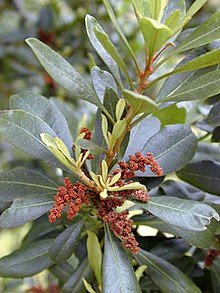Myricaceae: Difference between revisions
Appearance
Content deleted Content added
m Open access bot: doi added to citation with #oabot. |
|||
| Line 28: | Line 28: | ||
{{Clade| style=line-height:75%; |
{{Clade| style=line-height:75%; |
||
|1={{clade |
|1={{clade |
||
|1=[[Juglandaceae]] ( |
|1=[[Juglandaceae]] (Qrupdanxaric) |
||
|label2=Myricaceae |
|label2=Myricaceae |
||
|2={{clade |
|2={{clade |
||
|1=''[[Canacomyrica]]'' |
|1=''[[Canacomyrica]]'' |
||
|2={{clade |
|2={{clade |
||
|1=''[[ |
|1=''[[Comptonia]]'' |
||
|2={{clade |
|2={{clade |
||
|1=''[[Myrica]]'' |
|1=''[[Myrica]]'' |
||
|2=''[[ |
|2=''[[Morella]]'' |
||
}} |
}} |
||
}} |
}} |
||
Revision as of 21:53, 13 August 2020
This article needs additional citations for verification. (June 2016) |
| Myricaceae | |
|---|---|

| |
| Myrica faya | |
| Scientific classification | |
| Kingdom: | Plantae |
| Clade: | Tracheophytes |
| Clade: | Angiosperms |
| Clade: | Eudicots |
| Clade: | Rosids |
| Order: | Fagales |
| Family: | Myricaceae A.Rich. ex Kunth[1] |
| Type genus | |
| Myrica L. 1753
| |
| Genera | |
|
Canacomyrica Guillaumin | |

| |
| The range of Myricaceae. | |
The Myricaceae are a small family of dicotyledonous shrubs and small trees in the order Fagales. There are three genera in the family, although some botanists separate many species from Myrica into a fourth genus Morella. About 55 species are usually accepted in Myrica, one in Canacomyrica, and one in Comptonia.[2]
Well-known members of this family include bayberry and sweetfern.
- Canacomyrica Guillaumin 1940
- Comptonia L'Hér. ex Aiton 1789
- Myrica L. 1753 (includes: Morella Lour. 1790)
Systematics
Modern molecular phylogenetics suggest the following relationships:[3]
| |||||||
References
- ^ Angiosperm Phylogeny Group (2009). "An update of the Angiosperm Phylogeny Group classification for the orders and families of flowering plants: APG III" (PDF). Botanical Journal of the Linnean Society. 161 (2): 105–121. doi:10.1111/j.1095-8339.2009.00996.x. Retrieved 2013-07-06.
- ^ Christenhusz, M. J. M.; Byng, J. W. (2016). "The number of known plants species in the world and its annual increase". Phytotaxa. 261 (3): 201–217. doi:10.11646/phytotaxa.261.3.1.
- ^ Xiang XG, Wang W, Li RQ, Lin L, Liu Y, Zhou ZK, Li ZY, Chen ZD (2014). "Large-scale phylogenetic analyses reveal fagalean diversification promoted by the interplay of diaspores and environments in the Paleogene". Perspectives in Plant Ecology, Evolution and Systematics. 16 (3): 101–110. doi:10.1016/j.ppees.2014.03.001.
Wikimedia Commons has media related to Myricaceae.
